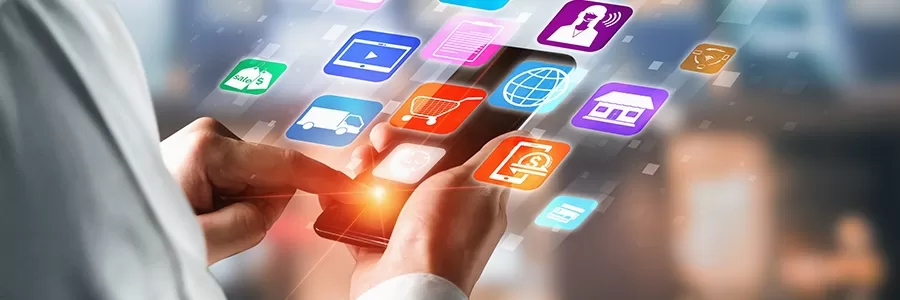Mobile application development involves developing software applications that can operate on mobile devices. The typical mobile application uses the network to communicate with computing resources from a remote location. Therefore the mobile development process involves the creation of software bundles that can be installed (code binaries, assets, and more.) as well as implementing backend features like data access through an API and testing the application on the target device.
Mobile application development involves creating software applications that can run on mobile devices. A typical mobile app uses the network to communicate with computing resources from a remote location. Thus, the mobile development process involves the creation of installable software bundles (code binaries, assets such as.), implementing backend features like data access using an API, and testing the app on target devices.
Mobile application development involves developing software applications that can run on mobile devices. The typical mobile application uses the network to communicate with computing resources from a remote location. Therefore, developing mobile apps involves creating installable software bundles (code binaries, assets, and more), implementing backend features like data access through an API, and testing the app on target devices.
Mobile application development involves developing software that runs on mobile devices. A typical mobile application uses an internet connection to interact with computing resources from a remote location. Thus, the mobile development process involves the creation of software bundles that can be installed (code binaries, assets, etc.) and implementing backend services, like data access through an API and testing the app on devices of the target.
Mobile Apps and Device Platforms
There are two major platforms in the modern smartphone market. One is the iOS platform, which Apple Inc owns. Its iOS platform powers the operating system behind Apple’s popular range of iPhone phones. The other is Android which is a product of Google. The Android operating system can be employed by Google devices and various other OEMs to build their smartphones and other smart devices.
While there are some differences between these two platforms for creating applications, the development process for iOS is different. Creating for Android requires using various Software Development Kits (SDKs) and distinct tools for development. While Apple only uses iOS for its device, Google makes Android available to other businesses, provided they satisfy certain requirements, including Google apps on their devices. Developers can create applications for millions of devices by focusing on both platforms.
- Alternatives to building Mobile Apps
- There are four primary design approaches to building mobile apps.
- Native Mobile Applications
- Native Mobile Cross-Platform Mobile Applications
- Hybrid Mobile Applications
- Progressive Web Applications
Each approach to developing mobile applications comes with distinct advantages and drawbacks. When deciding on the best development method for their projects, developers must consider the experience they would like users to have and the resources for computing and native features required to run the app. They also consider the development budget, timelines, and resources required to keep the app running.
Native Applications
Native mobile apps are developed using the frameworks and programming languages provided by the platform’s owners and run directly on mobile device operating systems, such as iOS and Android.
Cross-Platform Application
Native mobile apps that are cross-platform can be developed using a variety of frameworks and programming languages; however, they are then compiled into a native app that runs directly on the OS of the mobile.
Hybrid-Web Applications
Hybrid mobile apps are developed with standard web-based technologies, like JavaScript, CSS, and HTML5. They are included as installation packages for apps. Contrary to native applications, hybrid apps are built on a ‘web container,’ which offers the browser’s runtime and a bridge to native device APIs using Apache Cordova.
Progressive Web Applications
PWAs provide an alternative to mobile app development by avoiding the app store’s delivery and installation. PWAs are web apps that use browsers’ features, for example, operating offline or running a background process and ad-hoc links to the device’s home screen, providing an app-like experience for users.
Pros
Best performance during runtime Single code base for all platforms. The shared code base for mobile and web apps. The same app is available for mobile and web.
Access direct to devise APIs. It is easy to build and maintain your application using web development skillsets for mobile app development Installation is not required; accessible via the URL
Cons
More expensive costs for building and maintaining your application Depend upon bridges, libraries, and other components native device features – Less performance compared to native apps capabilities for features native to the device.
Multiple code bases for every platform performance limitations due to bridges – limited compatibility with native features of devices App features depend on the browser being used.
Comparing Native with. Hybrid Software
At the top scale, there are four primary ways native apps differ from hybrid apps, as depicted in the following table.
- Native Hybrid
- Platform Particular Cross Platform
- Compiled Language Scripting/Compiled
- Access to Hardware Plugins for Devices’ Native Modules
- Platform Frameworks Frameworks for Web Frameworks
Why Choose the Hybrid/Cross-platform Approach?
One of the issues when developing native mobile applications is that it demands a specific set of skills. While there are huge and active developer communities that are active for C and Java — the two languages families utilized for native development there are few developers that are proficient in the specific platforms for these languages and the respective development IDEs. In reality, proficient native application developers are in such high demand that many businesses have difficulty hiring and retaining them, which is why they often require external third-party design and development firms to develop their apps.
What are the ways Hybrid as well as Cross-platform Frameworks Perform?
Hybrid applications allow developers to utilize web-based technologies such as HTML5/CSS/JavaScript and then wrap these web applications into an environment that allows the web application to function like a native application running on the device. Since hybrid mobile applications are web applications that run on an embedded browser, most of the code from an online application can be used to create an app for mobile devices. Since mobile browsers’ running time and rendering performance are increasing, hybrid development can be a viable option for developers who want to create mobile applications quickly.
Similar to that, PWAs are written using traditional web application programming techniques, generally incorporating some variation or combination of JavaScript, HTML5, and CSS, and can be accessed via a browser installed on the device or the computer.
Most cross-platform frameworks, such as React Native and Native Script, provide native components that integrate with cross-platform code. Some others, like Flutter and Xamarin, convert cross-platform code into native code to enhance performance.
The Mobile Application Development Lifecycle
There are two interconnected core elements of a mobile app 1.) The mobile app “Front-End” that is installed on the smartphone, and secondly) the service “Backend” supports the front end of mobile devices.
Front-end vs. Backend
At the beginning of the current smartphone application, the mobile application industry underwent a similar transformation to the first websites. In the beginning, the apps and websites were completely on their own and served as merely static ads for the company, brand product, or service.
As connectivity and network capabilities increased and the apps became more connected to various sources of data and other information that were not part of the application itself as well as becoming more dynamic, as they were able to modify their interface and content based on information gathered over the network from data sources and queries.
In the process, mobile front-end applications are becoming more dependent on and integrated with backend services that provide information accessed through your mobile’s front end. This data could include, for instance, information about products for e-commerce apps or flight details for reservation and travel apps. In the case of mobile games, it could include new levels, challenges or scores, or avatars of other players.
How does the Front-end “talk” with the Backend?
The mobile front end receives data from the Backend using various APIs and service calls. In certain situations, these APIs could be managed and owned by the same organization developing the mobile app. In other instances, the API might be operated by a third party, and access to it is given to the mobile app through a commercial agreement.
For instance, a developer could access social media or other advertising content through calls to advertising or media company services. In this scenario, the developer might have been required to agree on a deal to be granted credentials as well as a key that gives access to an API and determines how the developer can utilize it, what they will have to pay, the frequency at which it can be called, or even how many data requests can be made in what time.
Why do developers use a cloud backend?
In most applications, mobile developers are responsible for establishing and managing backend services for their applications. Mobile developers may not have the expertise or may even be skilled enough to spin up and run backend infrastructure.
In this scenario, developers could opt to use cloud services providers – such as a backend-as-a-service provider, which handles all the tedious tasks and heavy lifting of managing backend capabilities so that developers can concentrate on the feature and features they’re developing for their apps and not be concerned about security, scalability and the reliability of the service.
The Front-End of Mobile Applications
The mobile front end of the application is the visual and interactive portion of the app that the users experience. It typically is installed within the phone, or at the very least, an icon that represents the app on the main screen or is displayed within the application catalog on the device. The application is open for download from the app store for platforms and then side-loaded onto devices or accessed via the device’s browser, like when it comes to PWAs.
What does a Front-end Development Workflow look like?
Suppose a developer claims that they’re a mobile app programmer. In that case, they typically refer to the front-end portion of the application and are proficient in the technologies and languages utilized to build this front-end app.
Based on the size of the team creating this app, multiple individuals might be involved in developing and designing the mobile application’s front end. The team size can vary from one developer who handles all the work in building the app to hundreds, tens, and many more with specialization.
For instance, graphic or creative designers might be responsible for creating visual elements for applications such as backgrounds, icons, themes, colors, and other application components. They may also be responsible for user interface and user experience designs that focus on the design of the components and their interaction with one another and the user. For certain games, a team could comprise motion graphics developers and engineers who design engines that regulate the mechanics of how components move, such as cars in a racing game.
How can Mobile Apps integrate into the Backend?
No matter how big the group is, an essential part of the development process is creating the logic for the app that makes network calls to backend systems, retrieves data, and then updates the backend systems by adding data generated by the application.
These backend services are generally accessible through various APIs, most frequently referred to as APIs. There are various APIs, such as REST and GraphQL. There are many ways and methods of accessing these APIs. While some APIs for backend services can be accessed directly by the app via calls made to the platform, many require integration into the application using the software development kit, often referred to as the SDK. After the SDK has been integrated into the app through the development environment, the app can take advantage of the APIs defined by the SDK.
How can I interact with the backend data?
A backend application for mobile front-ends could include a database that holds details used in the application. To be able to access the database, the mobile app developer will need to be aware of the location on the network of this database and the method used for connecting to the database, the credentials needed for authenticating and authorizing access, as well as the specific commands required by the database to access the required data.
Alternatively, the developer could use a specific API to communicate with the database. The developer might only have to know the parameters required for a method call to retrieve or update the information required. In certain cases, the mobile developer could create these APIs on their own or utilize the API specification that is provided by the operator/owner of the resource backend.
A REST API is generally used to communicate with cloud-based data sources, for example, cloud databases. An API like GraphQL API is another choice for developers as it allows for easy backend data within the mobile app. GraphQL allows for querying via one API endpoint and a data schema used to create and easily expand models for data utilized in the application.
The Back-End of Mobile Applications
Whether or not the front-end development platform or methodology delivers quality mobile applications that impress and retain users depends on high-quality backend support.
In light of the importance of backend services to the mobile application’s performance, programmers are faced with various critical design decisions to consider. These include which services they should develop and which third-party services they should use and then manage or maintain their services or services provided by third parties.
The solution is becoming clearer for developers: to increase their effectiveness and productivity, mobile application developers should develop their services only if they are tailored to the app’s specifics and contain exclusive intellectual property. In addition, even for services they create, they should always rely on cloud-based services to develop and maintain the backend infrastructure.
Key Mobile Application Services
Mobile app developers can utilize many cloud-based and third-party applications to speed up their apps’ development and distribution. But, developers will unlikely be skilled in all of these services.
Instead, mobile app developers should seek an environment for development that makes it easy for them to incorporate, utilize and utilize the most common capabilities within their apps quickly and efficiently while preserving the ability to use the numerous individual services offered.
- Essential
- Management and Sign-up for Users
- Login to social networks (Facebook login, Twitter sign-in, etc.)
- Users and Analytics
- Push Notifications
- Real Device Testing
- Data Services
- Cloud Storage
- Online and Real-time Data
- Cloud and Application Logic Functions
- Machine Learning
- Bots for Conversation Bots
- Images and Videos Recognition
- Speech Recognition
Mobile app developer in Kerala, IOS Mobile App Development In Trivandrum , E-Commerce Mobile Application Development






Leave a Reply